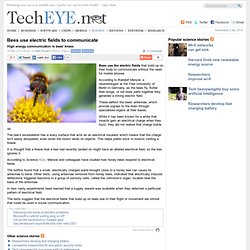

Bees use electric fields to communicate - High energy communication is bees' knees. Bees use the electric fields that build up on their body to communicate without the need for mobile phones.

According to Randolf Menzel, a neurobiologist at the Free University of Berlin in Germany, as the bees fly, flutter their wings, or rub body parts together they generate a strong electric field. These deflect the bees' antennae, which provide signals to the brain through specialised organs at their bases.
While it has been known for a while that insects gain an electrical charge when they buzz, they did not realise that charge builds up. The bee's exoskeleton has a waxy surface that acts as an electrical insulator which means that the charge isn't easily dissipated, even when the insect lands on objects. This helps pollen stick to insects visiting a flower. It is thought that a flower that a bee had recently landed on might have an altered electrical field, so the bee ignores it.
According to Science Now, Menzel and colleagues have studied how honey bees respond to electrical fields. Bees Buzz Each Other, but Not the Way You Think. The electric fields that build up on honey bees as they fly, flutter their wings, or rub body parts together may allow the insects to talk to each other, a new study suggests.

Tests show that the electric fields, which can be quite strong, deflect the bees' antennae, which, in turn, provide signals to the brain through specialized organs at their bases. Scientists have long known that flying insects gain an electrical charge when they buzz around. That charge, typically positive, accumulates as the wings zip through the air—much as electrical charge accumulates on a person shuffling across a carpet. And because an insect's exoskeleton has a waxy surface that acts as an electrical insulator, that charge isn't easily dissipated, even when the insect lands on objects, says Randolf Menzel, a neurobiologist at the Free University of Berlin in Germany. Now, in a series of lab tests, Menzel and colleagues have studied how honey bees respond to electrical fields. When Sparks Fly. Detection and Learning of Floral Electric Fields by Bumblebees. Bee Buzz Creates Electric Field That Helps Insects Communicate. By Sid Perkins The electric fields that build up on honey bees as they fly, flutter their wings, or rub body parts together may allow the insects to talk to each other, a new study suggests.

Tests show that the electric fields, which can be quite strong, deflect the bees' antennae, which, in turn, provide signals to the brain through specialized organs at their bases. Scientists have long known that flying insects gain an electrical charge when they buzz around. Bees Can Sense the Electric Fields of Flowers.
A bumblebee visits a flower, drawn in by the bright colours, the patterns on the petals, and the aromatic promise of sweet nectar.

But there’s more to pollination than sight and smell. There is also electricity in the air. Dominic Clarke and Heather Whitney from the University of Bristol have shown that bumblebees can sense the electric field that surrounds a flower. They can even learn to distinguish between fields produced by different floral shapes, or use them to work out whether a flower has been recently visited by other bees.
Flowers aren’t just visual spectacles and smelly beacons. “This is a big finding,” says Daniel Robert, who led the study. The Menzel Research Group. Neurobiology and the Behavior of the Honeybee Our research group applies a top-down approach with the aim of understanding the neural and cellular basis of sensory perception (olfactory, visual), learning, and memory in honeybees.

We chose the honeybee because it learns fast and effectively at the feeding site and, under constraint, in laboratory conditioning. Memory in bees is a dynamic self-organizing process that runs through phases and leads to life-long stability. Sensory capacities can be scrutinized with training techniques and related to the eco-evolutionary conditions for which they were developed. We try to relate the various levels of analysis to each other by asking the same questions at the behavioral, neural, cellular, and molecular level.
German version Our current research projects on honeybees are: 1. Menzel / Greggers 2. Hempel de Ibarra / Wertlen 3. Hempel de Ibarra / Niggebrügge 4. Komischke 5. Die Intelligenz der Bienen - Randolf Menzel.